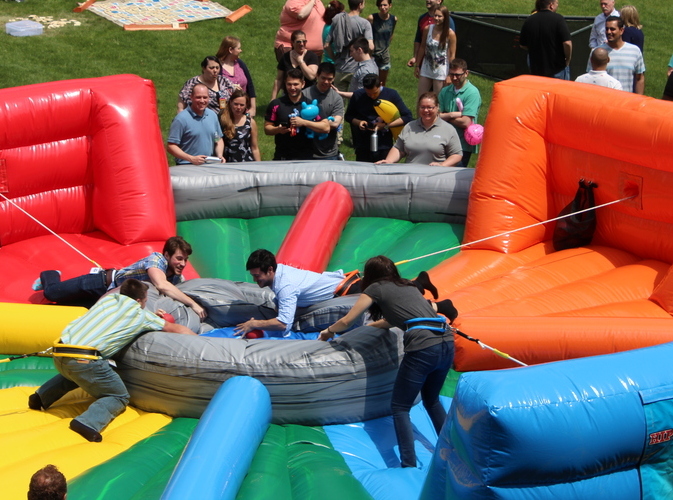Team Building Exercises – Planning Activities that Actually Work
You’ve probably been involved in a team-building activity at some point.
Perhaps it was a weekend retreat, or an afternoon at the climbing gym learning to rely on one another, or a day on the golf course getting to know everyone.
But, whether or not you and your colleagues enjoyed the experience, what happened when your team members returned to the office? Did they go back to their usual behavior – perhaps arguing over small assignments, or refusing to cooperate with each other? The ‘day of fun’ may have been a nice break from business, but did your colleagues actually use any of the lessons that they learned once they were back in the workplace?
Too often, managers plan an activity with no real thought or goal in mind. This tends to be a waste of time – and managers risk losing the team’s respect when they plan an exercise that doesn’t actually help those involved.
Team-building activities can be a powerful way to unite a group, develop strengths, and address weaknesses – but only if the exercises are planned and carried out strategically. In other words, there has to be a real purpose behind your decision to do the exercise – for example, improving the team’s problem-solving or creativity skills – rather than because you felt like giving your people a nice day out of the office.
This article shows you what to consider when planning a team event, and we offer a variety of exercises to address different issues that teams commonly face.
Team Building That Actually Builds Teams
The most important step when planning a team-building activity comes at the very beginning: you must start by figuring out what challenges your team faces. Only then can you choose exercises that will be effective in helping them work through these issues.
Spend time thinking about your team’s current strengths and weaknesses. Ask yourself these questions to identify the root of any problems:
START MAIN
* Are there conflicts between certain people that are creating divisions within the team?
* Do team members need to get to know one another?
* Do some members focus on their own success, and harm the group as a result?
* Does poor communication slow the group’s progress?
* Do people need to learn how to work together, instead of individually?
* Are some members resistant to change, and does this affect the group’s ability to move forward?
* Do members of the group need a boost to their morale?
Improving Communication
Back-to-Back Drawing – Divide your group into pairs, and have each pair sit on the floor back to back. Give one person in each pair a picture of a shape, and give the other person a pencil and pad of paper. Ask the people holding the pictures to give verbal instructions to their partners on how to draw the shape – without actually telling the partners what the shape is. After they’ve finished, ask each pair to compare their original shape with the actual drawing, and consider the following questions:
* How well did the first person describe the shape?
* How well did the second person interpret the instructions?
* Were there problems with both the sending and receiving parts of the communication process?
Survival Scenario – This exercise forces your group to communicate and agree to ensure their ‘survival.’ Tell your group that their airplane has just crashed in the ocean. There’s a desert island nearby, and there’s room on the lifeboat for every person – plus 12 items they’ll need to survive on the island. Instruct the team to choose which items they want to take. How do they decide? How do they rank or rate each item?
Eliminating Stereotypes and “Labeling”
Stereotype Party – This is a fun exercise for a medium-sized or large group. Write on nametags many different ‘personality types (see the list below), and pin or tape one tag to each person’s back. Don’t show people which tag is on their back – they’ll be able to see everyone else’s tag, but not their own.
Now, ask each person to figure out which personality type is on his or her back by asking stereotype-based questions of other people – “Am I a man?” “Am I an athlete?” “Am I an entertainer?” and so on.
Allow group members to answer only yes or no, and encourage participants to ask questions to as many different people as possible.
Here are some personality types you could consider:
* Auto mechanic.
* Olympic medalist.
* Professor.
* Fast-food restaurant worker.
* Postal worker.
* Movie star.
Building Interdependence and Trust
Human spring – Ask group members to stand facing each other in pairs. Their elbows should be bent, with their palms facing toward each other. Instruct them to touch their palms together, and gradually start leaning toward each other, so that they eventually hold each other up. Then, instruct everyone to move their feet further and further back, so that they have to depend solely upon their partners to remain standing.
Mine field – This is a great exercise if you have a large room or outdoor field. Set up a ‘mine field’ using chairs, balls, cones, boxes, or any other object that could potentially be an obstacle and trip someone up. Leave enough space between the objects for someone to walk through.
Next, divide your group into pairs. Pay attention to who you match with whom. This is a perfect opportunity to work on relationships, so you might want to put together people who have trust issues with each other. Blindfold one person, the ‘mine walker’ – this person is not allowed to talk. Ask his or her partner to stay outside the mine field, and give verbal directions, helping the mine walker avoid the obstacles, and reach the other side of the area.
Before you begin, allow partners a few minutes to plan how they’ll communicate. Then, make sure there are consequences when people hit an obstacle. For example, perhaps they have to start again from the beginning.
What Not to Do
If you were a marathon runner, would you train just a few times a year for your next race? Of course not. You would run almost every day. Why? Because only through regular, continuous training and exercise would you have a chance at winning.
Team building works on the same principle. Most managers plan one or two events per year, and that’s it. There’s rarely any regular ‘training’ or follow-up, and this can hold back the group’s long-term success.
Effective team building needs to happen continuously if you want your group to be successful. It needs to be part of the corporate culture.
If you lead a group, aim to incorporate team-building activities into your weekly or monthly routine. This will help everyone address their different issues, and it will give them a chance to have fun, and learn to trust one another – more than just once or twice a year.
Finally, make sure that your team-building exercises aren’t competitive. Think about it – competition tends to make one person or team work against another.
This probably isn’t a good way to build team spirit and unity. More likely, it’s a way to divide a group.
Many companies use sports for team-building activities. Yes, baseball and soccer can be fun, and some people will enjoy it. But these activities can do far more harm than good if they focus just on competing, and they can really de-motivate people who are not particularly good at these sports. Plan an event that makes people truly depend on others to succeed, and stay away from competition and ‘winning.’
Key Points
For team building to be effective, leaders must first identify the issues their group is facing. Then they can plan activities to address these challenges directly – and make sure that the team will actually gain some benefits from the event. Keep competition out of the exercises, and aim to make team building part of the daily corporate culture, instead of a once-a-year event.
By the Mind Tools Editorial Team
www.mindtools.com
Tags In
Related Posts
Categories
- All (16)
- Corporate (32)
- Fitness (26)
- Fun (25)
- Goal Setting (26)
- Leadership (32)
- Recommendations (10)
- Sports (23)
- Team Building (38)
- Uncategorized (1)




